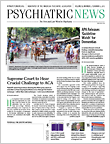“My day starts in pitch black,” high school sophomore Claire Heiden told the Fairfax County, Va., School Board when it met last October to vote on delaying the county’s present 7:20 a.m. high school start time.
Students who ride school buses often rise before 5 a.m. and leave home at 5:30 a.m., Heiden said. Those who commute by car—relatively new drivers and often barely awake, she asserted—face the added challenge of driving in the dark.
“The evidence for later school start times is clear and compelling,” Phyllis Payne, M.P.H., a Fairfax parent and health educator, said at the meeting. More than a decade ago, Payne told Psychiatric News, she rose before dawn to tend a child, glanced outside, and saw her babysitter and other teenagers gathered under a streetlight waiting for their school bus.
In 2004, Payne and another parent, Sandy Evans, now a school-board member, cofounded the Start Later for Excellence in Education Proposal (SLEEP), a community group advocating later opening-bell times and increased sleep education in the curriculum. Their group submitted a petition to the board with more than 10,000 signatures of people favoring the delay.
After hearing these and other presentations, including one opposing the delay, the board voted 11 to 1 to accept a plan to start school later developed by sleep specialists at Children’s National Medical Center in Washington, D.C.
Beginning in September, classes will start between 8 a.m. and 8:10 a.m. and end between 2:45 p.m. and 2:55 p.m. for more than 57,000 students in Fairfax County’s 22 high schools. Students attending three middle schools located on high school campuses will follow the high school schedule. Remaining middle schools will open at their current start time, 7:30 a.m. Elementary schools will start at the same time they do now, or within five to 10 minutes of that time, with openings varying from 8 a.m. to 9:20 a.m.
The new schedule will cost $4.9 million to implement, mainly to purchase 27 new buses to reduce extremely early pickup times.
Students Can Get 50 Minutes More Sleep
The new start times will give all Fairfax public high school students and some middle school students the opportunity to sleep 40 to 50 minutes longer on school nights than they do now, Judith Owens, M.D., a professor of pediatrics at George Washington University School of Medicine and Health Sciences, told Psychiatric News. Studies in communities that have delayed start times show students do not stay up later, Owens said. They go to bed at the same time and get more sleep.
Owens directs sleep medicine at Children’s National Medical Center. She and colleagues received a $143,000 grant from the Fairfax County School Board in 2013 to develop workable scenarios for starting school later.
Because the start-time debate had roiled Fairfax for years, Owens and her team sought broad community involvement. The team held eight town-hall meetings at which more than 1,000 people offered opinions on four options. It also reviewed 3,000 emails area residents sent via its website.
Start Times, Biological Clocks Out of Sync
Most adolescents need 8.5 to 9.5 hours of sleep for optimum alertness and well-being, said Owens, who chairs the American Academy of Pediatrics (AAP) Adolescent Sleep Working Group. Few get that amount, AAP said in a policy statement published in Pediatrics in September 2014. That’s because school start times are not in sync with adolescents’ biological clocks.
Two-thirds of Fairfax students in grades 8, 10, and 12 reported in a 2011 survey that they averaged seven hours or less sleep on school nights, and 29 percent reported symptoms of depression, findings that alarmed the school board and the community.
According to the AAP, “The average teenager in today’s society has difficulty falling asleep before 11 p.m. and is best suited to wake at 8 a.m. or later.” The AAP urged the nation’s middle and high schools to start classes at 8:30 a.m. or later—30 to 60 minutes later than most do now. While Fairfax’s 8 a.m. or later start times fall short of that goal, they are a positive first step, Owens said, and a practical compromise considering the community’s size—385 square miles—traffic woes, and other factors.
“We have found every minute of delay useful,” Kyla Wahlstrom, Ph.D., director of the Center for Applied Research and Education Improvement at the University of Minnesota and a longtime investigator of school start-time changes, told Psychiatric News. “The greater the delay, the greater the benefit.”
When school starts later, Wahlstrom said, attendance rises; tardiness falls; academic performance improves in the core subjects of English, math, social studies, and science; and scores rise on national standardized tests. Students who average eight hours or more sleep each night report fewer symptoms of depression and thoughts of suicide than those who usually sleep less than eight hours.
Schools have ample time to prepare for the new schedules, said Fairfax County Public Schools Superintendent Karen Garza. “Because we are such a large and diverse district,” she said, “the changes likely will be easier for some parents and more challenging for others.”
Most Fairfax County middle school students still will start classes earlier than sleep specialists recommend, Owens said. Her team hopes to assess the impact of the new start times and to work with the school board to explore further delays. ■
“Children’s National Medical Center Blueprint for Change” can be accessed
here.
